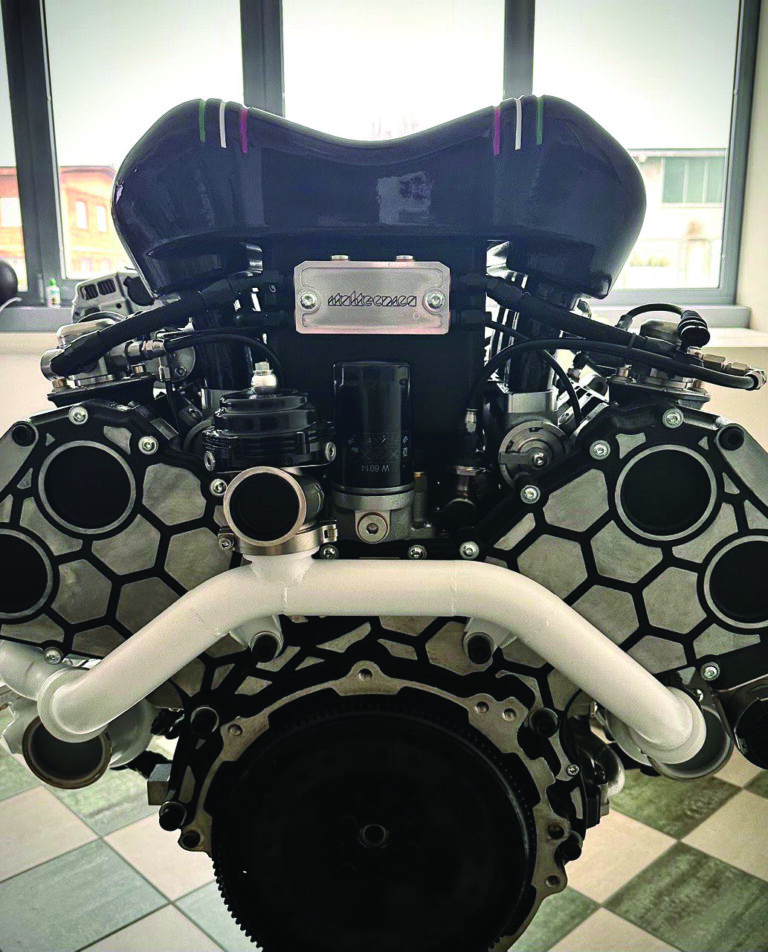In 2022, Italtecnica, a family-run engine building business based in Cambiano, Italy, unveiled a sequentially twin-turbocharged, three-liter V6 featuring a pre-chamber combustion system developed in-house. There are two versions of the engine in development: an initial variant targeting the Hypercar class of Le Mans prototypes, and a second iteration intended for road use.
According to Carlo Cavagnero, technical director on the project, the engine was conceived as a showcase for the company’s capabilities, with engineering input also provided by the internal combustion engine department of Politecnico di Milano and Italian engine supremo Claudio Lombardi, of Ferrari fame.

Solid base
A 90° bank angle was chosen because, says Cavagnero, this was determined to give the best balance between packaging and performance. The engine is a compact unit, with many of its ancillaries packaged within the vee, including the oil cooler, charge cooler, oil filter and air-oil separator for the dry-sump lubrication system.
“The block is designed to be a stressed member and so is the oil pan,” notes Cavagnero, adding that the oil pan also carries the lower crank bearing caps as well as having the multistage oil pump built into its structure. The crank pins have a 120° offset with an odd-firing spacing of between 90° and 150°, with the firing order running 1-6-3-4-2-5.
The internals are relatively conventional by race engine standards. For example, the valves are actuated by rocker arms and finger followers, via two camshafts per bank, driven by a combination of gears and chain. Cavagnero says that a chain final drive for the cams was chosen to easily accommodate potential variations in the block height due to machining over the engine’s service life. The use of any form of variable valve timing system was eschewed because, in Cavagnero’s opinion, the benefits in a turbocharged racing engine are minimal yet any such system would carry a weight penalty.

However, there are some innovative elements within the valvetrain. Notably, the exhaust valves, developed by Eaton Corporation (with which Italtecnica has a close working relationship), are hollow, with both the head and the stem filled with sodium. “That gives us a very light valve but also one that runs very cool, around 150°C lower than the ones without sodium-filled heads,” Cavagnero says. “Running very lean mixtures is better for the valve and better for heat transfer.”
Careful attention has been paid to the cooling system, with combustion chamber temperature control an important factor in ensuring stable combustion. “We wanted to attain good heat balance within the engine. The bores have liners and we use a stainless-steel multilayer head gasket with orifices to optimize the cooling flows to the cylinder head. The coolant mass flow through the head is maximized around the exhaust ports and then flows around the rest of the head from there,” explains Cavagnero.
Lean running
The headline feature of the Italtecnica engine is its pre-chamber ignition system, which is key to achieving stable combustion of the lean mixtures needed to realize the impressive 45% thermal efficiency. The system has a centrally mounted pre-chamber incorporating a spark plug, and a separate injector fires horizontally into the combustion chamber, which runs in combination with port injectors.
Asked why the company opted to develop the system in-house rather than use a design from a supplier such as Mahle, Cavagnero says the choice was driven by engineering and business concerns. With the engine acting as a showcase for the company’s capabilities, the plan is to make the pre-chamber system (which is patented) available to automotive OEMs as a retrofit solution for existing engine platforms. Thus it was logical to pursue a passive system due to its ease of integration, although designs for an active system were also drawn up.

Packaging the pre-chamber into the combustion chamber was a challenge. “You must fit big valves for the volumetric efficiency, a direct injector and the pre-chamber itself within the combustion chamber. The placement of the pre-chamber within the chamber, the turbulence within the pre-chamber and the location of the spark plug are all very important,” outlines Cavagnero, adding that the pre-chamber is not much larger than a traditional spark plug.
The feature that sets the Italtecnica pre-chamber apart from others is its behavior at low load and idle conditions, where passive setups can suffer due to insufficient scavenging inside the pre-chamber, leading to misfires. This is mitigated by the position of the spark plug, which sits very close to the tip of the chamber, a solution proposed by Lombardi. The effectiveness of this layout was validated first through extensive CFD simulation by Politecnico di Milano and later via bench testing, with a focus on optimizing the turbulent flows in the pre-chamber and around the spark plug under a range of running conditions.
Prototype development was initially undertaken on a single-cylinder engine. “This allowed us to assess in-cylinder parameters,” explains Cavagnero, “such as instantaneous pressures, indicated parameters and combustion stability, to validate the simulation model test under critical engine operating conditions.”
During the engine’s test program, the knock sensing system was calibrated through the use of in-cylinder pressure transducers, with the V6 using a total of four knock sensors, two per bank. Cavagnero notes that during the early stages of prototype running, the MAPO (maximum amplitude pressure oscillation) values were greater than one would find in a standard combustion engine. However, it was determined that this was not due to pre-ignition occurring but rather a reflection of the very rapid combustion that is possible with the pre-chamber.
“When we started development work with the single-cylinder, we were not aware of this phenomenon and were a little worried. But after we tore the engines down, we could see that all was well and there was no evidence of knock,” Cavagnero says. He also states that both the piston and the combustion chamber have a surface treatment to protect against knock and reduce heat transfer from the combustion chamber.

The engine is still under development and Cavagnero admits that at high-RPM, high-load running, engineers are still establishing whether the combustion is spark initiated or they are into the realms of compression ignition. “We don’t yet understand whether the engine is actually operating in HCCI at high RPM and boost.”
The compression ratio is high for a turbocharged engine; 12:1 to 13:1 versions have been tested with regular pump gasoline, and higher ratios were tested with bioethanol fuel.
Injection strategies
The V6 features port and direct injection systems. Cavagnero explains that this enables the benefits of each to be exploited under different operating conditions and loads. At lower RPM, the control afforded by direct injection enables operation near to the knock limit; however, at higher engine speeds and wide-open throttle, port injection is favored given the limited ability of direct injector technology to provide the required fuel volume.
Outlining how the mixture preparation varies through the engine’s operating range, Cavagnero states that at low RPM there is a very lean, homogeneous mixture in the combustion chamber and a richer mixture within the pre-chamber – around lambda 0.9. Achieving a homogeneous charge is necessary to minimize particulate emissions. At higher RPM, the charge in the combustion chamber remains homogeneous, but within the pre-chamber the mixture is stratified.

The direct injection system still has a role to play at higher RPM. “The direct injector works at higher RPM to fill the pre-chamber,” reveals Cavagnero. “The lambda of the pre-chamber is controlled by the direct injector, but at high RPM the homogeneous charge is achieved with the port injector.”
Another related area of intensive development was the geometry of the piston crown. “Getting this design correct was quite difficult because of the lateral injector spray. You have to ensure it does not spray under the liners, and also you cannot have excessive tumble inside the chamber to keep volumetric efficiency high.” The impact of tumble also had to be balanced against volumetric efficiency at higher operating RPM. While tumble is beneficial to mixture preparation for direct injection, if the effect is too pronounced it can impede volumetric efficiency at high engine speeds. This, reveals Cavagnero, has influenced the design of the inlet manifold (which incorporates throttle barrels), the inlet port and piston crown and the placement of the in-cylinder injector.
Sequential strategy
Key to the concept of Italtecnica’s V6 is the sequential turbocharging setup, deployed to provide low-speed response from the engine (without any hybrid torque fill) while also catering for the not inconsiderable mass flow and boost demand at high RPM. Carlo Cavagnero contrasts this approach to that taken in F1, where engine manufacturers have used increasingly large compressors but with the support of electrical assistance (the MGU-H) to keep response rates low. For Italtecnica, the obvious solution was to use a sequential setup of two smaller turbochargers.
The turbocharging system had to be tailored to support the considerable air demand at high lambda values and the boost pressure required to hit the necessary performance level (670hp in Le Mans Hypercar). To this end, the engine is designed to handle peak combustion pressures of 200 bar that correspond to a simulated peak power equal to 750hpat 8,000rpm.

At lower speeds, below 4,000rpm, only one of the turbochargers is deployed – reducing lag – with two valves: a one-way valve preventing flow being diverted back to the idle turbocharger and an anti-lag valve electronically managed to help spin up the second turbocharger. As engine speed increases, and depending on load, the second turbocharger comes into play in parallel with the first, the transition governed via a closed-loop system controlling the wastegate and the aforementioned valves. The results are impressive. In the roadgoing version, maximum boost is available from 3,000rpm, with maximum torque available from 3,000-6,000rpm, and a peak power of 600bhp. For the racing variant, the torque band moves up to 4,000-6,500rpm with peak power at 8,000rpm.
At time of going to press, Italtecnica is reporting considerable interest in the engine, although most of it is confidential. However, Cavagnero reveals that Totem Automobili, which produces bespoke, carbon-bodied Alfa Giulia restomods, has already taken delivery of two engines, and a total of 12 are due to be supplied by the end of 2024 for fitment in its GT Super models. There is also ongoing development of the pre-chamber ignition system aimed at mainstream automotive.

Vital statistics
Layout: 90°, V6
Induction: Twin, sequential turbocharged. Pre-chamber ignition
Power: 750hp @ 8,000rpm
Fuel: Gasoline



